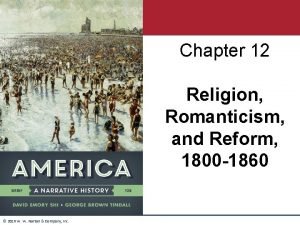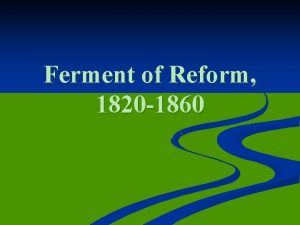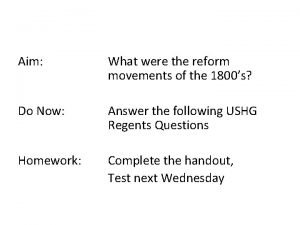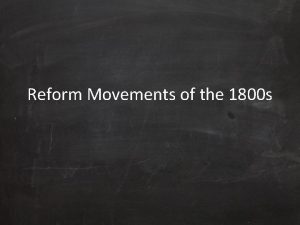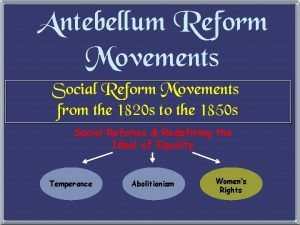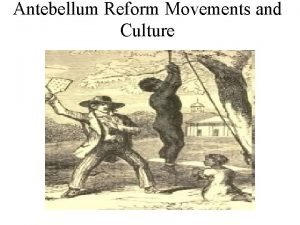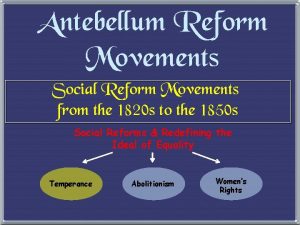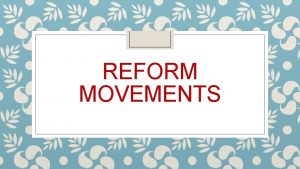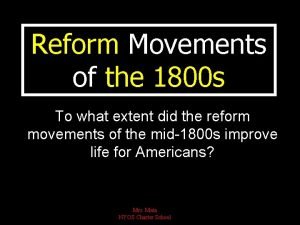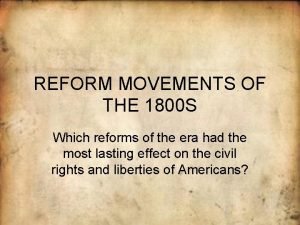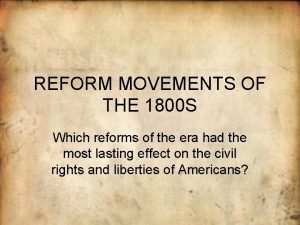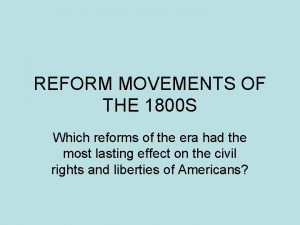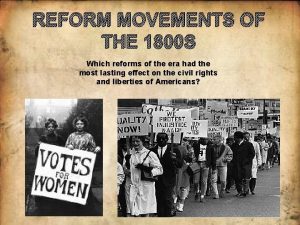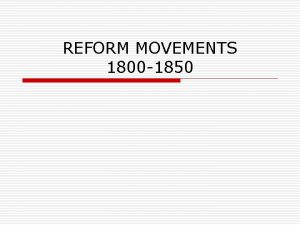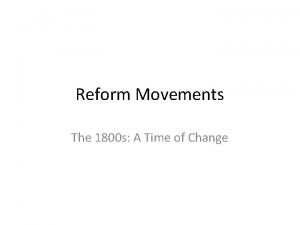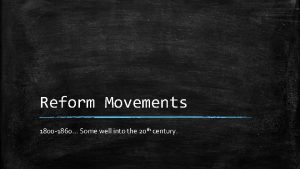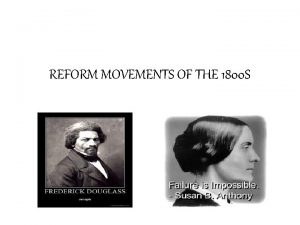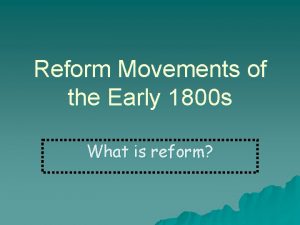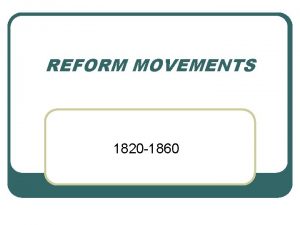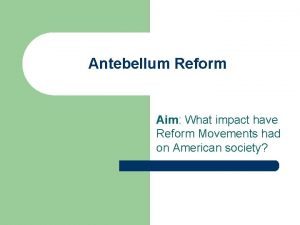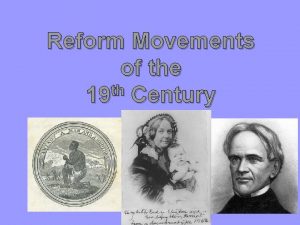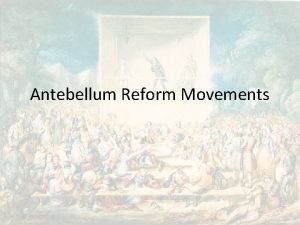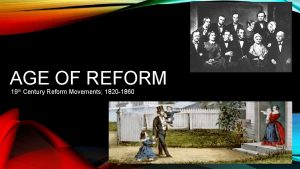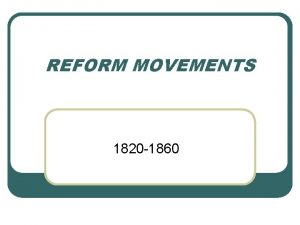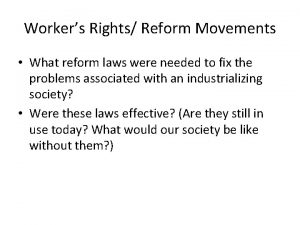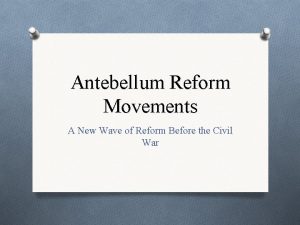Reform Movements of the 1800 s n o

















![the sick and insane were "confined in this Commonwealth [Massachusetts] in cages, closets, cellars, the sick and insane were "confined in this Commonwealth [Massachusetts] in cages, closets, cellars,](https://slidetodoc.com/presentation_image/a1ddac6d6551fb3c5a1eeace6cbaa6a9/image-18.jpg)




















- Slides: 38

Reform Movements of the 1800 s n o i t a E c u d Abolition f o e Ca r the d e l b a Dis Pris on s ’ n e m o W s t h Rig Tem pera nce

People Involved Horace Mann (1796 -1859) • Believed that the key to reform was better education • Secretary of the Massachusetts state board of education • Established state normal schools (colleges for teachers) • Ideas included: • improvement of schoolhouses and equipment • better pay for teachers • controversial ideas about coeducation (boys and girls together)

Before reform: • No unified approach; different communities had different attitudes and systems • Schools were more common in New England • Southern students were more likely to be taught at home • Some religious communities provided education • Girls received far less education than boys • Few African-Americans had educational opportunities • After Nat Turner’s revolt, it was illegal to teach slaves to read or write • No formal teacher training (Poorly trained teachers) • “Poor” schools were rarely attended because of parents’ pride and the fact that many poor children worked in factories

Education Reform • States adopted education standards (but not all at once) • Mann published the bi-weekly Common School Journal • Teacher colleges (normal schools) were established • More children of various backgrounds received education • Education was free , paid for with tax dollars

Education Reform Impact on Society: • Educated persons help improve society and the economy • Powerful instrument for social unity • Providing all children with a common set of values and skills

Prison Reform Dorothea Lynde Dix (1802 - 1887) Dorothea Dix • Toured prisons and insane asylums to gather information • Testified before various state legislatures about the appalling conditions • Traveled to Europe and appealed to the Queen of England the pope

Prison Reform Conditions prior to reform: Prisoners chained to walls Intended to punish, not rehabilitate Children and adults incarcerated together Beatings and torture

Accomplishments Slowly turned to the idea of rehabilitation Isolation for the worst offenders Education services brought in Women and children were in separate facilities • Some U. S. prisons became the model other countries followed • •

Abolition "immediate emancipation!" Fredrick Douglass William Lloyd Garrison I could, as a free man, look across the bay toward the Eastern Shore where I was born a slave.

Prior to reform: • Slaves are forbidden to learn to read • “Black Codes: ” Laws passed to repress slaves in order to prevent rebellion • Expansion of cotton growing in the south increases the demand for slavery • The South’s entire economy and culture becomes based on slavery • Anti- slavery sentiment grows in the North Photo shows scars left from whippings on a slave’s back

Accomplishments: • Anti- slavery societies grow in the North • Uncle Tom’s Cabin is published and becomes a best seller • Rallies and conventions are held • William Lloyd Garrison publishes “The Liberator ” • Eventually: • Abraham Lincoln issues the Emancipation Proclamation • After the Civil War, the 13 th, 14 th and 15 th amendments to the Constitution are passed

People Involved Susan B. Anthony Elizabeth Cady Stanton Lucretia Mott

Prior to Reform… Women were not treated as equal to men • Married women were considered "Legally Dead" • Not allowed to vote • Had no property rights • Not allowed to enter professions in medicine or law • Not permitted to enroll in college • Couldn't participate in church affairs • Were completely dependent on men

“The Inspectors of Election By Whom Her Vote was Received. ”

Seneca Falls Convention We hold these truths to be selfevident: that all men and women are created equal; that they are endowed by their Creator with certain inalienable rights; that among these are life, liberty, and the pursuit of happiness… Excerpt from the “Declaration of Rights and Sentiments, ” adopted at the Seneca Falls Convention

Amelia Bloomer introduced her design for women’s trousers called “Bloomers. ” At the time, they were considered scandalous.

Care of the Disabled Thomas Hopkins Gallaudet (1787 -1851) Samuel Gridley Howe (1801 -1876), Pioneer of education for the blind Pioneer of deaf education Dorothea Lynde Dix (1802 -1887, Pioneer of prison, hospital and asylum reform
![the sick and insane were confined in this Commonwealth Massachusetts in cages closets cellars the sick and insane were "confined in this Commonwealth [Massachusetts] in cages, closets, cellars,](https://slidetodoc.com/presentation_image/a1ddac6d6551fb3c5a1eeace6cbaa6a9/image-18.jpg)
the sick and insane were "confined in this Commonwealth [Massachusetts] in cages, closets, cellars, stalls, pens! Chained, beaten with rods, lashed into obedience. "

Accomplishments… Thomas Hopkins Gallaudet (1787 -1851) pioneered in the education of deaf children by founding the first free school in Philadelphia for deaf children in 1817. Samuel Gridley Howe (1801 -1876), provided for the sightless some of the same reforms Gallaudet pioneered for the deaf. For 44 years Howe ran the New England Asylum for the Blind. In addition, he also advocated asylums for the insane and retarded. Dorothea Dix (1802 -1887), born in Maine, was outraged at the treatment of the insane and the mentally retarded. She lobbied tirelessly to publicize the inhuman conditions in poorhouses and basements where the insane were often kept in chains. Her efforts led to the creation of new hospitals and asylums in 15 states and in Canada.

Temperance Movement Carrie Nation Lyman Beecher

Prior to Reform… • Drunkenness was reaching catastrophic levels • Lost wages • High crime • Broken families (mostly afflicted men) • Whiskey (made from corn) was cheaper than milk or beer and safer to drink than water! • In 1820 the amount of hard liquor drunk person was 3 times what it is today!

What conclusion can be drawn from the information in the chart? A. Americans in the early 1800 s were not serious users of alcohol B. The Temperance Movement of the 1830 s helped reduce alcohol use C. Abolitionists opposed drinking of alcoholic beverages D. By the time of the Civil War, America was becoming a “nation of drunkards” Year Amount of Alcohol Consumed by Each Person 1800 6. 6 gallons 1810 7. 1 gallons 1820 6. 8 gallons 1830 7. 1 gallons 1840 3. 1 gallons 1850 1. 8 gallons Source: America, Pathway to the Present Making predictions – what do you think the 1860 consumption level would be?

Temperance propaganda…


Look at the differences between the Tree of Temperance and the Tree of Intemperance

The sweet “fruits” of temperance

The bitter “fruits” of intemperance

Accomplishments ● Women figured prominently in leadership roles ● Hard liquor consumption dropped by 50% in the 1830 s ● By 1860 13 states had prohibition laws making alcohol illegal

The Second Great Awakening

What was The Second Great Awakening? The Second Great Awakening was a Christian religious revival movement during the early 19 th century in the United States, which expressed the idea that every person could be saved.

Influence on Society • Preached that selfishness was the root of sin and evil • Influenced many reform movements , especially prison reform, abolition, temperance and care for the disabled and insane • By doing charitable work (God’s work) one could be saved • Church membership soared • New Christian denominations are established

Key Figures Thomas Campbell, Methodist Preacher Joseph Smith, Founder of the Church of Jesus Christ of Latter Day Saints (Mormons)


Art, Literature and Culture TEKS 8. 26 A: describe developments in art, music, and literature that are unique to American culture such as the Hudson River School artists, John James Audubon, "Battle Hymn of the Republic, " transcendentalism, and other cultural activities in the history of the United States

Hudson River School Artists Not an actual school, but an artistic trend in 1800 s America. Named because of its beginnings in the Hudson River Valley of New York State and after many of the earlier paintings that depicted this region of the country.

Three main themes: • Discovery • Exploration • Settlement Characterized by: • Realistic, detailed, idealized portrayal of nature • Many show no evidence of Man’s impact • When humanity (or evidence of humanity) is portrayed, it shows man in harmony with nature Artists believed that nature (especially American nature) is a manifestation of God.

Transcendentalism Henry David Thoreau Ralph Waldo Emerson • natural world is a doorway to the spiritual/ideal world • Intuition (feeling) is superior to rationality (thinking) • self-reliance and individualism outweigh blind conformity to custom, tradition, and authority • non-conformists • do not follow society, but rather do it their own way

John James Audubon • Ornithologist (expert on birds) and painter. • Famous for his highly accurate and detailed illustrations of American birds in their natural habitat.
 W.w. norton
W.w. norton Second great awakening
Second great awakening Reform movements def
Reform movements def Reform movements 1800s
Reform movements 1800s Phrenology apush
Phrenology apush Locomotor and axial movements examples
Locomotor and axial movements examples Quá trình desamine hóa có thể tạo ra
Quá trình desamine hóa có thể tạo ra Các môn thể thao bắt đầu bằng từ đua
Các môn thể thao bắt đầu bằng từ đua Cong thức tính động năng
Cong thức tính động năng Hình ảnh bộ gõ cơ thể búng tay
Hình ảnh bộ gõ cơ thể búng tay Khi nào hổ con có thể sống độc lập
Khi nào hổ con có thể sống độc lập Thế nào là mạng điện lắp đặt kiểu nổi
Thế nào là mạng điện lắp đặt kiểu nổi Dot
Dot Nguyên nhân của sự mỏi cơ sinh 8
Nguyên nhân của sự mỏi cơ sinh 8 Vẽ hình chiếu đứng bằng cạnh của vật thể
Vẽ hình chiếu đứng bằng cạnh của vật thể Phản ứng thế ankan
Phản ứng thế ankan Gấu đi như thế nào
Gấu đi như thế nào Thiếu nhi thế giới liên hoan
Thiếu nhi thế giới liên hoan điện thế nghỉ
điện thế nghỉ Một số thể thơ truyền thống
Một số thể thơ truyền thống Thế nào là hệ số cao nhất
Thế nào là hệ số cao nhất Trời xanh đây là của chúng ta thể thơ
Trời xanh đây là của chúng ta thể thơ Lp html
Lp html Bảng số nguyên tố
Bảng số nguyên tố đặc điểm cơ thể của người tối cổ
đặc điểm cơ thể của người tối cổ Phối cảnh
Phối cảnh Các châu lục và đại dương trên thế giới
Các châu lục và đại dương trên thế giới Chụp tư thế worms-breton
Chụp tư thế worms-breton ưu thế lai là gì
ưu thế lai là gì Hệ hô hấp
Hệ hô hấp Tư thế ngồi viết
Tư thế ngồi viết Bàn tay mà dây bẩn
Bàn tay mà dây bẩn Mật thư tọa độ 5x5
Mật thư tọa độ 5x5 Bổ thể
Bổ thể Tư thế ngồi viết
Tư thế ngồi viết V cc
V cc Thẻ vin
Thẻ vin Thơ thất ngôn tứ tuyệt đường luật
Thơ thất ngôn tứ tuyệt đường luật Hát lên người ơi alleluia
Hát lên người ơi alleluia
